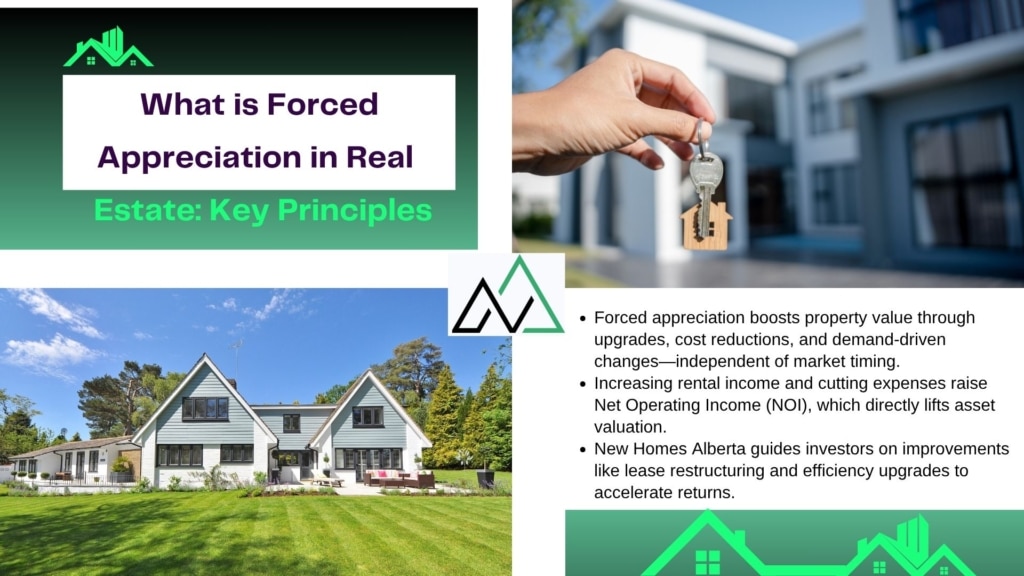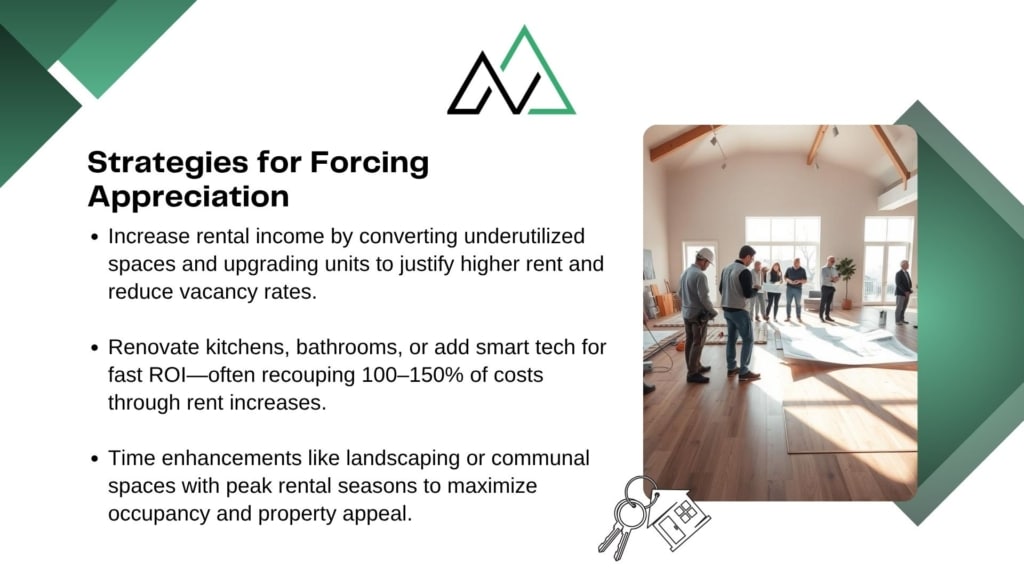Property owners and investors often rely on two types of value growth: natural market trends and intentional strategies. While market conditions can passively elevate prices over time, proactive approaches allow stakeholders to accelerate returns. This method involves targeted upgrades, operational efficiency, and repositioning assets to maximize income potential.
For example, renovating outdated interiors or optimizing rental management can directly boost net operating income (NOI). Higher NOI translates to increased asset valuations, creating opportunities for equity gains or refinancing. At New Homes Alberta, our team specializes in identifying these value-add opportunities for clients across Canada.
Whether you’re purchasing your first home or expanding an investment portfolio, understanding these techniques helps make informed decisions. This guide will explore practical methods to enhance market position, analyze potential challenges, and highlight how strategic planning creates lasting financial benefits.
Key Takeaways
- Proactive upgrades outperform passive market growth in building equity
- Net operating income directly impacts property valuations
- Strategic renovations often yield the highest return on investment
- Expert guidance helps navigate value-creation opportunities
- Market repositioning can unlock hidden asset potential
Introduction to Forced Appreciation Concepts
Property growth strategies fall into two categories: those controlled by external factors and those shaped by deliberate action. While markets fluctuate naturally, informed decisions allow stakeholders to actively influence asset performance. New Homes Alberta prioritizes educating clients about these distinct approaches to wealth building.

Market Trends vs. Strategic Improvements
Natural appreciation occurs when neighborhood demand or economic conditions lift prices organically. For instance, a new transit line might increase area desirability over 5-10 years. This passive growth depends on timing and location rather than owner involvement.
In contrast, force appreciation involves targeted upgrades that directly impact cash flow. Modernizing units to justify higher rents or renegotiating service contracts both fall under this category. These actions create measurable value increases within months rather than decades.
| Factor | Natural Appreciation | Force Appreciation |
|---|---|---|
| Speed | 3-7 years | 6-18 months |
| Control | Market-dependent | Investor-driven |
| ROI Predictability | Variable | Calculated |
Practical Benefits for Stakeholders
Understanding these models helps buyers and investors allocate resources effectively. A 2023 Calgary case study showed renovated units achieved 22% higher rents than unimproved neighboring properties. Proactive management reduces vacancy risks while maximizing monthly income.
New Homes Alberta’s advisors frequently guide clients through value-creation opportunities. Whether adjusting lease terms or upgrading amenities, strategic planning turns properties into high-performing assets.
What is forced appreciation in real estate: Key Principles
Accelerating property returns requires deliberate measures rather than waiting for market shifts. Strategic upgrades and financial optimization create measurable growth, even in stable economic conditions. This approach centers on three pillars: boosting revenue streams, refining operational costs, and aligning improvements with local demand.

How Proactive Strategies Drive Property Value
Raising rental rates through unit upgrades or amenity additions directly impacts cash flow. A 2023 Edmonton study revealed properties with modernized kitchens achieved 18% higher monthly income compared to outdated units. Simultaneously, renegotiating maintenance contracts or switching to energy-efficient systems can reduce annual expenses by up to 15%.
Net operating income (NOI) serves as the foundation for valuation calculations. Consider this formula:
Market Value = NOI ÷ Capitalization Rate
If renovations increase a building’s NOI from $80,000 to $95,000 in a 6% cap rate market, its value jumps from $1.33M to $1.58M – a $250,000 gain without relying on market swings.
| Value Driver | Action | Typical ROI Timeline |
|---|---|---|
| Rental Income | Lease term adjustments | 3-6 months |
| Operating Costs | Utility upgrades | 12-18 months |
| Asset Appeal | Exterior renovations | 6-12 months |
Interest rates significantly influence improvement decisions. When borrowing costs rise, focusing on low-cost upgrades like smart home installations often delivers better returns than major renovations. New Homes Alberta advisors recently helped a Calgary investor increase occupancy rates by 40% through targeted landscaping and improved tenant screening processes.
Strategies for Forcing Appreciation
Strategic property enhancements offer investors direct control over value growth. By focusing on income optimization and physical upgrades, stakeholders can achieve measurable results faster than market-dependent appreciation. Let’s explore practical methods to elevate asset performance.
Increasing Rental Income and Reducing Vacancies
Transforming underused areas into revenue streams creates immediate financial benefits. For example, converting unfinished basements into legal suites can add $800-$1,200 monthly in cities like Toronto. Adding in-unit laundry facilities or storage lockers often justifies 10-15% higher rents compared to basic units.

Adjusting lease terms to match current market rates reduces vacancy periods. A 2023 Vancouver case study showed properties offering 18-month leases with fixed annual increases maintained 95% occupancy versus 82% for month-to-month rentals.
| Renovation Type | Average Cost | Rent Increase Potential |
|---|---|---|
| Kitchen Modernization | $8,000-$12,000 | 18-22% |
| Bathroom Refresh | $3,500-$6,000 | 12-15% |
| Smart Home Tech | $2,000-$4,000 | 8-10% |
Renovations and Property Enhancements for Quick Gains
Targeted upgrades deliver the fastest returns. Refacing cabinets and installing quartz countertops typically recoup 150% of costs through higher rents. Energy-efficient windows and insulation improvements reduce utility bills while attracting eco-conscious tenants.
Adding functional living spaces like home offices or outdoor seating areas increases perceived value. A Calgary investor recently transformed a rooftop into a communal garden, boosting occupancy from 70% to 93% within four months.
Timing improvements with seasonal demand maximizes impact. Spring landscaping projects or pre-winter HVAC upgrades often yield better tenant response rates than off-peak renovations.
Operational Efficiencies and Lease Restructuring
Smart financial decisions often separate thriving properties from underperforming assets. By refining day-to-day operations and tenant agreements, owners can unlock hidden value while maintaining competitive positioning.
Optimizing Operating Expenses to Boost NOI
Efficient management practices reduce waste without compromising service quality. A 2023 Ontario study found properties using automated utility systems cut water bills by 23% annually. Renegotiating vendor contracts or switching to bulk purchasing often lowers maintenance costs by 12-18%.
Lease adjustments provide dual benefits: stabilizing income streams and attracting quality tenants. Consider these proven strategies:
- Offering 18-month leases with fixed 3% annual increases
- Including utility costs in rental rates for predictable budgeting
- Adding pet fees to offset potential damage costs
These tactics helped a Montreal apartment complex reduce vacancies from 15% to 4% within eight months. The property’s net operating income rose by $28,000 yearly, directly increasing its market valuation.
| Cost Category | Typical Savings | Impact on NOI |
|---|---|---|
| Landscaping | $1,200/year | +1.5% |
| Energy Systems | $4,800/year | +6.2% |
| Waste Management | $900/year | +1.1% |
Long-term returns improve when operational upgrades become standard practice. Regular expense audits and tenant satisfaction surveys help maintain momentum. As cap rates respond to improved NOI, property appreciation accelerates – creating lasting value for Canadian investors.
Benefits and Challenges of Forced Appreciation
Accelerating equity growth through property enhancements offers exciting potential but demands careful evaluation. Stakeholders must weigh immediate costs against lasting financial gains while navigating market variables.
Advantages: Faster Value Growth and Improved Cash Flow
Proven upgrades deliver measurable results. A 2024 Winnipeg case study revealed renovated units achieved 25% higher rents within six months. These improvements directly boost property values through increased net operating income.
Strategically applied changes often outperform market trends. Consider these outcomes:
| Improvement | Average ROI Timeline | Valuation Impact |
|---|---|---|
| Kitchen Remodel | 8-14 months | +18% |
| Energy Upgrades | 12-18 months | +9% |
| Landscape Design | 3-6 months | +5% |
Drawbacks: Time, Effort, and Financial Considerations
Estate investors frequently encounter unexpected hurdles. A Vancouver townhouse project required 40% more capital than planned due to permit delays. While appreciation occurs faster than passive growth, projects demand:
- Substantial upfront funding ($15k-$80k typical)
- 3-12 month timelines
- Continuous market monitoring
Successful real estate investment requires balancing these factors. Partnering with local experts helps mitigate risks while maximizing strategies that increase property value sustainably.
Implementing Forced Appreciation in Canadian Real Estate
Successfully enhancing property returns across Canada demands tailored approaches that align with regional economic patterns. Urban centers and suburban markets each present unique opportunities for value creation through strategic upgrades.
Local Market Considerations and Timing
Toronto’s competitive condo market rewards kitchen remodels with 20% faster leasing, while Calgary’s suburban single-family homes benefit most from basement suite conversions. Key factors influencing success:
- Municipal renovation permit timelines (4-12 weeks nationally)
- Seasonal demand fluctuations (spring/summer peak in most regions)
- Local tenant preferences (e.g., Vancouver’s emphasis on energy efficiency)
A 2024 analysis shows optimal purchase timing varies by province:
| City | Best Acquisition Period | Key Value Driver |
|---|---|---|
| Montreal | Q4 | Multi-unit conversions |
| Edmonton | Q2 | Energy retrofits |
| Ottawa | Q1 | Home office additions |
Expert Advice from New Homes Alberta
Our advisors prioritize three assessment criteria for Canadian investors:
- Neighborhood infrastructure development plans
- Existing property maintenance deficits
- Local rental rate growth projections
“Focus on properties with 15-20% below-market rents,” suggests New Homes Alberta’s investment team. “These assets offer clear pathways to boost cash flow through strategic improvements.”
Recent client successes include a Winnipeg triplex that achieved 32% NOI growth through targeted bathroom upgrades and lease restructuring. Partnering with local experts ensures alignment with provincial regulations and market trends.
Driving Equity Growth with Strategic Forced Appreciation
Strategic upgrades and operational refinements transform real estate assets into high-performing investments. By focusing on rental income optimization and cost efficiency, investors accelerate equity growth regardless of interest rate fluctuations. A 2024 Toronto study revealed renovated properties achieved 22% higher valuations through strategic improvements.
Proactive approaches deliver measurable results. Adjusting lease terms to match current market rates, modernizing units, and enhancing curb appeal directly boost cash flow and tenant retention. These methods create lasting value while minimizing reliance on unpredictable trends.
New Homes Alberta’s expertise guides stakeholders in maximizing returns. Whether optimizing existing assets or identifying undervalued properties, informed decisions yield superior appreciation potential. Ready to unlock your property’s full value?
Contact our team at (403) 305-9167 for tailored strategies that drive sustainable growth. First-time buyers and seasoned investors alike benefit from actionable insights that increase property value and strengthen financial portfolios.
FAQ
How does forced appreciation differ from market-driven value growth?
Forced appreciation results from intentional improvements like renovations or operational upgrades, while market-driven growth depends on external factors like economic trends or neighborhood development. Investors control forced appreciation through direct action.
Can lease restructuring improve a property’s net operating income?
Yes. Adjusting lease terms to reflect current market rates, reducing tenant turnover through incentives, or introducing graduated rent increases can stabilize cash flow and boost NOI – a key factor in valuation calculations.
What property upgrades deliver the fastest ROI for forced appreciation?
Cosmetic updates (fresh paint, modern fixtures), energy-efficient appliances, and functional space conversions (adding laundry facilities or storage) often yield quick returns. Focus on changes that justify higher rents without overspending.
How do interest rates impact forced appreciation strategies?
Rising rates increase financing costs, making value-add projects more selective. Investors might prioritize improvements with immediate rent premiums during high-rate periods, like adding smart home technology to attract quality tenants.
Why is vacancy reduction critical for forced appreciation?
Empty units drain cash flow and lower NOI. Implementing tenant retention programs, responsive maintenance, and competitive amenities reduces vacancies – directly increasing property value through stabilized income streams.
Does forced appreciation work in all Canadian housing markets?
While effective nationally, success depends on local factors. New Homes Alberta analysts recommend evaluating regional rent ceilings, renovation costs, and buyer demand before executing value-add strategies in specific communities.
How do property management practices influence forced appreciation?
Professional management minimizes expenses through vendor negotiations and preventive maintenance while maximizing occupancy. This operational efficiency increases NOI, creating compounding value over time.
What financial risks accompany forced appreciation methods?
Over-improving properties beyond neighborhood norms or miscalculating renovation costs can erode returns. Always conduct comparative market analyses and consult New Homes Alberta’s investment calculators before committing capital.





